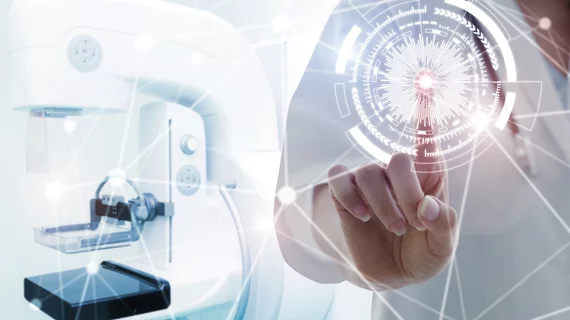AI accurately predicts breast cancer years before diagnosis
Artificial intelligence algorithms for breast cancer detection could predict disease development years before malignancy is identifiable on imaging.
A new paper in JAMA suggests that such software has the potential to signal breast cancer up to six years before it develops. This information could help providers personalize breast cancer screening strategies and initiate treatment earlier, authors of the new paper suggest.
“These AI algorithms have been developed to mark areas of concern and provide breast-level and examination-level malignant neoplasm scores to aid interpreting radiologists,” corresponding author Solveig Hofvind, PhD, from the Cancer Registry of Norway and Norwegian Institute of Public Health, and co-authors write. “However, emerging research suggests that these same AI scores may potentially detect imaging features associated with future breast cancers years before they are detected clinically.”
To evaluate the utility of AI to predict future risk, researchers retrospectively applied a commercially available algorithm (INSIGHT MMG, version 1.1.7.2; Lunit Inc.) to images from more than 116,000 women who underwent at least three consecutive biennial breast cancer screenings. The algorithm gave each exam a score of 0-100 based on findings suspicious for malignancy, with higher scores indicating heightened risk of a breast cancer diagnosis.
The mean risk scores for women who were eventually diagnosed with breast cancer during the first, second and third screenings were 21.3, 30.7 and 79. In comparison, women who did not develop cancer had mean scores of 9.9, 9.6 and 9.3, respectively.
Exam-level scores higher than 20 and differences in scores between breasts of 20 or more were both linked to increased risk of breast cancer. These score differences were consistently associated with eventual diagnoses, the group notes.
“Although current commercial AI tools, such as the one used in our study, were not developed or optimized for future cancer risk estimations, we found that the AI system’s discriminatory accuracy for estimating future screening-detected or interval cancer risk 4 to 6 years prior to diagnosis met or exceeded the performance of established risk calculators currently in wide use, such as the Tyrer-Cuzick model, the Breast Cancer Risk Assessment Tool, and the Breast Cancer Surveillance Consortium model,” the authors explain.
The team suggests that similar AI systems could optimize risk-based screening strategies. They indicate that their future work could expand to women with exams that were initially interpreted by radiologists as negative, but who eventually received a cancer diagnosis.
Learn more about the study’s findings here.

